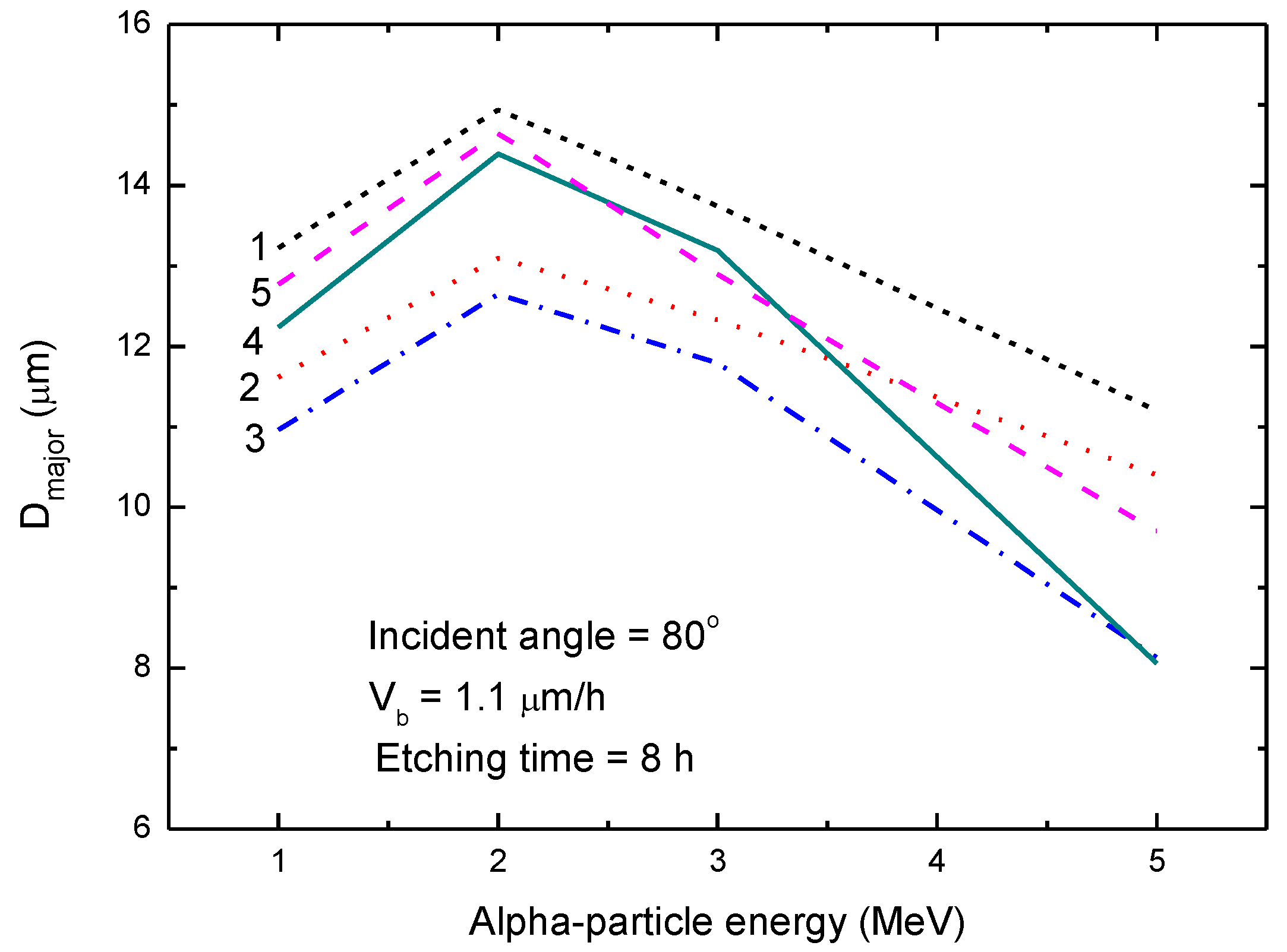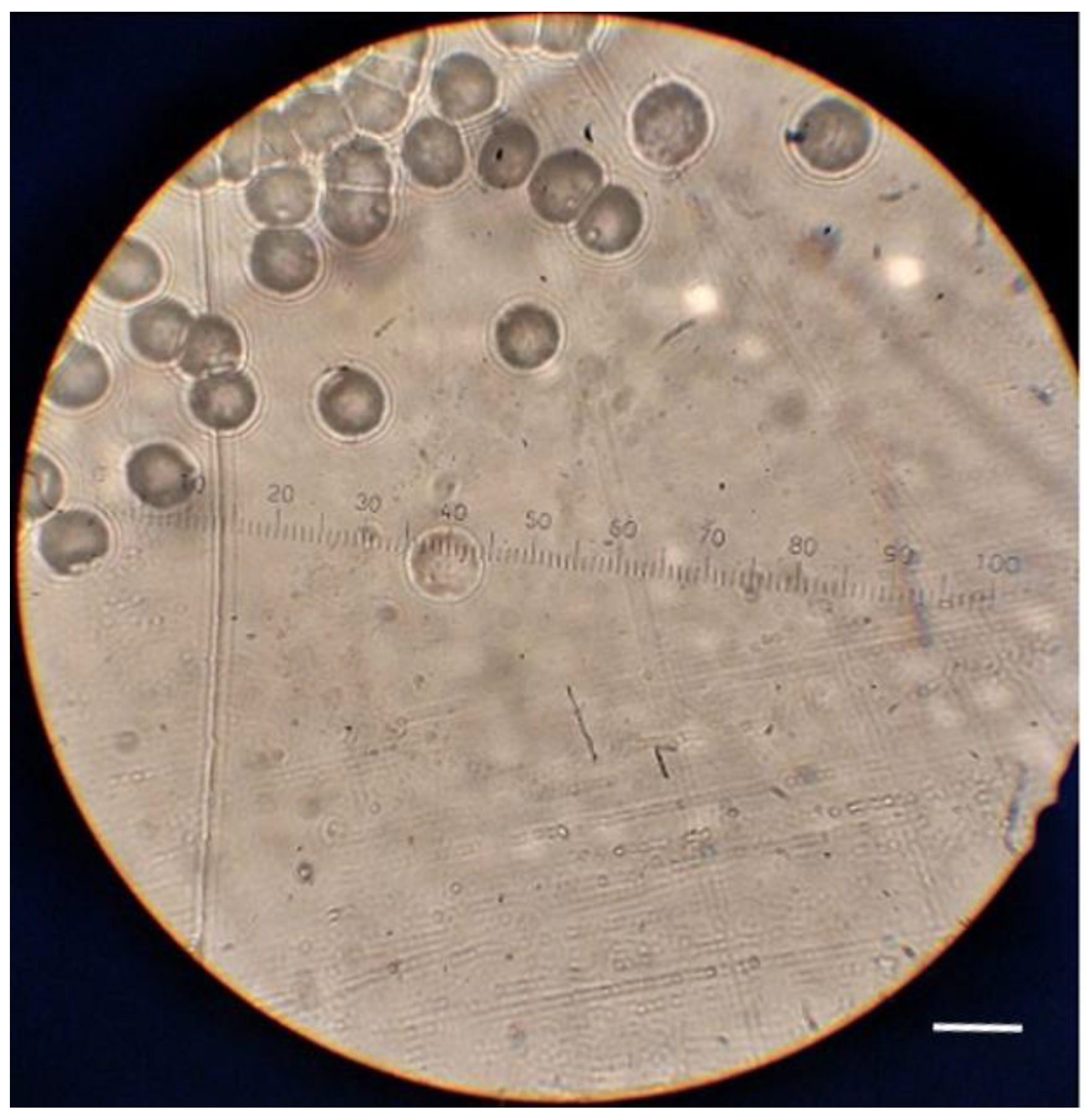Updates to TRACK_TEST and TRACK_VISION Computer Programs
Abstract
1. Introduction
2. TRACK_TEST, TRACK_VISION and TRACK_P
3. Modifications of TRACK_TEST
3.1. Programming and Simulation
3.2. Adding Two V Functions
3.3. Adding Makrofol Option
4. Modifications of TRACK_VISION
4.1. Programming and Simulation
4.2. Adding Two V Functions and Makrofol Option
5. Notes on Installing and Running TRACK_TEST 2.0 and TRACK_VISION 2.0
6. Conclusions
Author Contributions
Funding
Data Availability Statement
Conflicts of Interest
References
- Abu-Jarad, F.A. Application of nuclear track detectors for radon related measurements. Int. J. Radiat. Appl. Instrum. 1988, 15, 525–534. [Google Scholar] [CrossRef]
- Nikolaev, V.A.; Ilic, R. Etched track radiometers in radon measurements: A review. Radiat. Meas. 1999, 30, 1–13. [Google Scholar] [CrossRef]
- Steck, D.J.; Field, R.W. The use of track registration detectors to reconstruct contemporary and historical airborne radon (222RN) and radon progeny concentrations for radon-lung cancer epidemiologic study. Radiat. Meas. 1999, 31, 401–406. [Google Scholar] [CrossRef]
- Falk, R.; Almrén, K.; Östergren, I. Experience from retrospective radon exposure estimations for individuals in a radon epidemiological study using solid-state nuclear track detectors. Sci. Total Environ. 2001, 272, 61–66. [Google Scholar] [CrossRef]
- Bochicchio, F. Radon epidemiology and nuclear track detectors: Methods, results and perspectives. Radiat. Meas. 2005, 40, 177–190. [Google Scholar] [CrossRef]
- Yu, K.N.; Nikezic, D.; Ng, F.M.F.; Leung, J.K.C. Long-term measurements of radon progeny concentrations with solid state nuclear track detectors. Radiat. Meas. 2005, 40, 560–568. [Google Scholar] [CrossRef]
- Yu, K.N.; Nikezic, D. Long-term determination of airborne radon progeny concentrations using LR 115 solid-state nuclear track detectors. Radiat. Meas. 2011, 46, 1799–1802. [Google Scholar] [CrossRef]
- Nikezic, D.; Yu, K.N. Formation and growth of tracks in nuclear track materials. Mater. Sci. Eng. R. 2004, 46, 51–123. [Google Scholar] [CrossRef]
- Nikezic, D.; Yu, K.N. Computer program TRACK_TEST for calculating parameters and plotting profiles for etch pits in nuclear track materials. Comput. Phys. Commun. 2006, 174, 160–165. [Google Scholar] [CrossRef]
- Nikezic, D.; Yu, K.N. Computer program TRACK_VISION for simulating optical appearance of etched tracks in CR-39 nuclear track detectors. Comput. Phys. Commun. 2008, 178, 591–595. [Google Scholar] [CrossRef]
- Nikezic, D.; Yu, K.N. Three-dimensional analytical determination of the track parameters. Over-etched tracks. Radiat. Meas. 2003, 37, 39–45. [Google Scholar] [CrossRef]
- Nikezic, D.; Ivanovic, M.; Yu, K.N. A computer program TRACK_P for studying proton tracks in PADC detectors. SoftwareX 2016, 5, 74–79. [Google Scholar] [CrossRef]
- Durrani, S.A.; Bull, R.K. Solid State Nuclear Track Detection. Principles, Methods and Applications; Pergamon Press: Oxford, UK, 1987. [Google Scholar]
- Brun, C.; Fromm, M.; Jouffroy, M.; Meyer, P.; Groetz, J.E.; Abel, F.; Chambaudet, A.; Dorschel, B.; Hermsdorf, D.; Bretschneider, R.; et al. Intercomparative study of the detection characteristics of the CR-39 SSNTD for light ions: Present status of the Besancon—Dresden approaches. Radiat. Meas. 1999, 31, 89–98. [Google Scholar] [CrossRef]
- Yu, K.N.; Ng, F.M.F.; Nikezic, D. Measuring depths of sub-micron tracks in a CR-39 detector from replicas using atomic force microscopy. Radiat. Meas. 2005, 40, 380–383. [Google Scholar] [CrossRef]
- Durrani, S.A.; Green, P.F. The effect of etching conditions on the response of LR 115. Nucl. Tracks 1984, 8, 21–24. [Google Scholar]
- Yip, C.W.Y.; Nikezic, D.; Ho, J.P.Y.; Yu, K.N. Chemical etching characteristics for cellulose nitrate. Mater. Chem. Phys. 2006, 95, 307–312. [Google Scholar] [CrossRef]
- Yu, K.N.; Ho, J.P.Y.; Nikezic, D.; Yip, C.W.Y. Determination of the V function for CR-39 by atomic force microscope. In Recent Advances in Multidisciplinary Applied Physics; Mendez-Vilas, A., Ed.; Elsevier: Amsterdam, The Netherlands, 2005; pp. 29–34. [Google Scholar]
- Al-Jubbori, M.A. V-function to investigate tracks of the alpha particle irradiated CR-39 detector. Radiat. Meas. 2020, 136, 106388. [Google Scholar] [CrossRef]
- Hermsdorf, D. Evaluation of the sensitivity function V for registration of α-particles in PADC CR-39 solid state nuclear track detector material. Radiat. Meas. 2009, 44, 283–288. [Google Scholar] [CrossRef]
- Stajic, J.M.; Milenkovic, B.; Nikezic, D. Study of CR-39 and Makrofol efficiency for radon measurements. Radiat. Meas. 2018, 117, 19–23. [Google Scholar] [CrossRef]
- Benton, E.V.; Nix, W.D. The restricted energy loss criterion for registration of charged particles in plastics. Nucl. Instrum. Methods 1969, 67, 343–347. [Google Scholar] [CrossRef]
- Somogyi, G.; Grabisch, K.; Scherzer, R.; Enge, W. Revision of the concept of registration threshold in plastic track detectors. Nucl. Instrum. Methods 1976, 134, 129–141. [Google Scholar] [CrossRef]
- Ziegler, J.F.; Ziegler, M.D.; Biersack, J.P. SRIM: The stopping and range of ions in matter. Nucl. Instrum. Methods Phys. Res. B 2010, 268, 1818–1823. [Google Scholar] [CrossRef]
- Nikezic, D.; Ng, F.M.F.; Yip, C.W.Y.; Yu, K.N. Application of ray tracing method in studying alpha tracks in SSNTDs. Radiat. Meas. 2005, 40, 375–379. [Google Scholar] [CrossRef]
- Yu, K.N.; Lee, H.H.W.; Wong, A.W.T.; Law, Y.L.; Cheung, S.F.L.; Nikezic, D.; Ng, F.M.F. Optical appearance of alpha-particle tracks in CR-39 SSNTD. Nucl. Instrum. Methods Phys. Res. B. 2007, 263, 271–278. [Google Scholar] [CrossRef]




| 1 | 2 | 3 | 4 | 5 | |
|---|---|---|---|---|---|
| a | 0.1744 | −0.0672 | 0.3396 | 0.0921 | 1761.3219 |
| b | 1.6652 | 1.2607 | 4.2000 | 1.1676 | 50.0726 |
| c | 0.3549 | 0.0460 | 1.4294 | 0.0444 | 23.0569 |
Publisher’s Note: MDPI stays neutral with regard to jurisdictional claims in published maps and institutional affiliations. |
© 2021 by the authors. Licensee MDPI, Basel, Switzerland. This article is an open access article distributed under the terms and conditions of the Creative Commons Attribution (CC BY) license (http://creativecommons.org/licenses/by/4.0/).
Share and Cite
Nikezic, D.; Stajic, J.M.; Yu, K.N. Updates to TRACK_TEST and TRACK_VISION Computer Programs. Polymers 2021, 13, 560. https://doi.org/10.3390/polym13040560
Nikezic D, Stajic JM, Yu KN. Updates to TRACK_TEST and TRACK_VISION Computer Programs. Polymers. 2021; 13(4):560. https://doi.org/10.3390/polym13040560
Chicago/Turabian StyleNikezic, Dragoslav, Jelena M. Stajic, and Kwan Ngok Yu. 2021. "Updates to TRACK_TEST and TRACK_VISION Computer Programs" Polymers 13, no. 4: 560. https://doi.org/10.3390/polym13040560
APA StyleNikezic, D., Stajic, J. M., & Yu, K. N. (2021). Updates to TRACK_TEST and TRACK_VISION Computer Programs. Polymers, 13(4), 560. https://doi.org/10.3390/polym13040560




_Kwan_Ngok_Yu.png)


